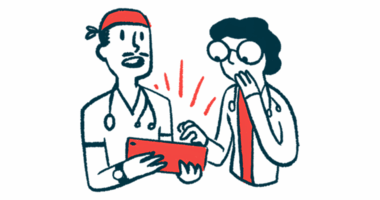Fellow MG Patients, We Know Our Bodies the Best

Around age 5, I began having difficulty walking. A couple of times a day I would get a strange, pins-and-needles sensation in my right leg. I was young and didn’t think much of it. When my parents became aware, they were concerned. Multiple doctors told us not to worry. My mother persisted. They told her it was growing pains.
Ma wouldn’t be pacified. She had other children and understood growing pains. In those long-ago days, a mother’s observations didn’t impress many doctors. There was more than a hint of misogyny.
Eventually, due largely to Ma’s insistence, we found ourselves at Boston Children’s Hospital, where I was diagnosed with a brain tumor and underwent two surgeries. The first was to remove the tumor, and the second was to reconstruct the right side of my skull. My mother had been right.
Luck blessed me three times. Due to early detection, complete removal of the tumor was possible. I had parents who understood their child’s body. They trusted their knowledge and instincts enough to know when something was wrong. Lastly, I had care from a gifted neurologist who listened to a mother’s observations.
That experience taught me a valuable lesson. Doctors, despite their best intentions, aren’t always right. A patient should listen carefully to medical experts, but patients’ observations about their bodies are crucial, valid information. Careful combination of these two informs good decisions.
In 2020, I was diagnosed with myasthenia gravis (MG). To bring the MG under control, I was prescribed large doses of prednisone. I had little experience with the medicine and was unaware of its many side effects. I faced a learning curve as I struggled to learn about MG and its treatments. Eventually I would learn about a negative side effect of prednisone.
In May 2021, I began experiencing mobility issues. By July 4, I was unable to walk without assistance. Swelling developed on my inner left thigh, and I began experiencing horrific back, leg, and groin pain.
My neurologist ordered MRIs of my spine, and my general practitioner (GP) ordered sonograms of my groin. I had four visits to emergency rooms. Throughout I kept asking about the swelling in my thigh. Repeatedly I was told it was nothing — perhaps fat deposits. My body told me there was more to it.
I grew frustrated and lashed out. Friends were frightened during a discussion about my mobility problems when I exploded with “Why won’t someone listen to me? Could someone who knows what they’re doing look at my dang leg?” That someone soon came into my life.
Last December a severe myasthenic crisis landed me in Maine Medical Center. There, I was under the care of a wonderful doctor. I told him about the swelling, and he examined my thigh. He ordered an X-ray, and when he read it, he saw something wrong with the bone. He wanted an MRI done immediately.
The MRI confirmed what I had known for almost a year. There was something wrong with my left leg! Large doses of prednisone, necessary to bring my MG under control, resulted in avascular necrosis of my left hip. The bone died from lack of blood supply. The diagnosis wasn’t good news, but at least the mystery was solved.
Today, I’m unable to walk and confined to the house. I’ll have hip replacement surgery July 19. I’m grateful, but I wonder if the pain and suffering of the past year might have been avoided. When I told doctors I was sure something was wrong with my leg, this shouldn’t have been dismissed. Maybe the bone wouldn’t have died. Perhaps surgery wouldn’t have been necessary. Just conjecture!
I was reluctant to challenge a doctor. More than once my observations were met with “When did you graduate from medical school?” Unsure of myself, I’d answer, “Never. But I’ve been with this body since day one and know it better than anyone.”
My GP and neurologist are second to none, and when developing a treatment plan, their recommendations were crucial. Input from family and friends was incredibly valuable. My observations about my body were just as crucial and valuable. Successful treatment requires a combination of medical expertise, patient observations, and input from significant people in the patient’s life.
A rare disease diagnosis sends you into uncharted territory. Rely on the advice of medical experts. Listen to your family and friends. But don’t forget, nobody knows your body better than you.
Myasthenia Gravis News is strictly a news and information website about the disease. It does not provide medical advice, diagnosis, or treatment. This content is not intended to be a substitute for professional medical advice, diagnosis, or treatment. Always seek the advice of your physician or other qualified health provider with any questions you may have regarding a medical condition. Never disregard professional medical advice or delay in seeking it because of something you have read on this website. The opinions expressed in this column are not those of Myasthenia Gravis News or its parent company, Bionews, and are intended to spark discussion about issues pertaining to myasthenia gravis.








Carol hayter
In march 2020 I was diagnosed with M G. I was put on high doses of prednisone. I knew something was not right. I also have been with my body since day one. I called my doctors office numerous times and was able to only talk to his office nurse. When I kept telling her something was not right and she kept telling me it is just the side effect of the medication. August 16 I had a heart attack and was in hospital 5 days due to overdose of prednisone and nobody would take me seriously and I am an R.N.
Norm
I second your observation "... nobody knows your body better than you."
I think the order of knowledgeableness is (1) you, (2) your doctor, and remote (3) the insurance company (who have never seen you, even from afar).
I have had episodes of severe shoulder pain (related or not to my MG). My doctor requested an MRI, and was denied by my insurance company. Instead, they offer three or four levels of appeals of the denial.
Some doctors may milk the system, but most do not. Their firsthand knowledge of the patient and expertise should be respected.
paul spychalski
Most Doctors only believe what they say and not what you say. I was diagnosed with: Vertigo, Meiners, Ataxia, and one Nero. Doc said nothing to help. I get help from the VA as I was in S. Vietnam, they are looking into my double vision, dropped foot, stumbling and falling. They gave me a rollator to help me walk, my son gave me a VFW Oak Cain to help w/short walks. The VA took a CT scan of my Thymus and are getting me Prism glasses. It's a shame my civilian Doctors didn't help.
Oh Well....
Andy Coyne
It strikes me that MG patients the world over face the same problems with poor routes to diagnoses and doctors, not us, in denial of sometimes obvious symptoms. Fortunately I was diagnosed fairly quickly by a great young ophthalmologist. My patient journey hasn’t been smooth. I had a neurologist who was a stroke specialist who was actually relieved when I independently got a second opinion from a prof of neurology 120 mikes away. I’ve been met with challenges in hospital with breathing issues and told it was a panic attack. I’m still suffering with that so called panic attack six months later! Fortunately my neuro prof is on the case and changed my diagnoses from ocular to generalised.